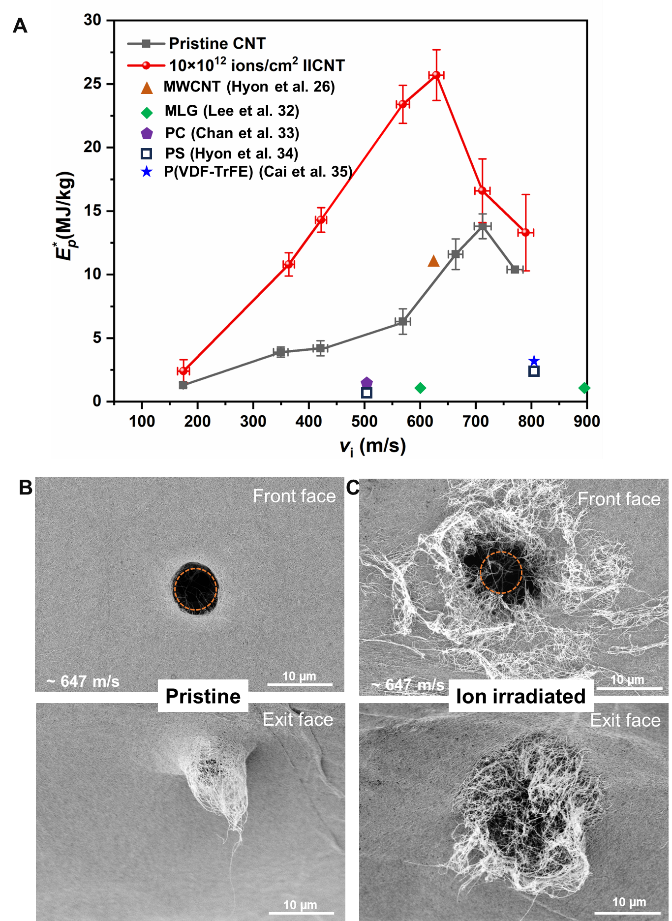Prof. WU Xianqian from the Institute of Mechanics, Chinese Academy of Sciences, Prof. THOMAS Edwin L. from Texas A&M University, and their teams developed a strategy to fabricate carbon nanotube films with specific energy absorption up to 26 MJ/kg. This work has been published in Science Advances with the title of “Load sharing and accumulated bond fracture in ion-irradiated carbon mat for energy dissipation.” on Nov 27.
Defects are typically regarded as a detrimental factor that decreases the intrinsic strength of materials, thereby reducing their impact resistance. However, is this principle universal across different material systems and defect scales? Can the internal defects of materials be utilized to enhance the impact resistance?
To answer this question, they therefore took multi-walled carbon nanotubes (MWNT) film as a model material, which is comprised of disordered networks of multi-walled carbon nanotubes. Using high-energy carbon ion irradiation, they introduced atomic-scale defects into the CNTs, which decreased the strength of individual CNTs. However, these atomic-scale defects change the deformation behavior of the MWNT under micro-ballistic impact and enhanced significantly the impact resistance of the MWNT film. The specific energy absorption (SEA) of the MWNT film reached an unprecedented value of 26 MJ/kg, surpassing the existing record of films (Figure 1).

Fig.1.Dynamic performance of CNT mat.(A)Specific penetration energy (E*p)of 245-nm-thick pristine and ion irradiation CNT films versus impact velocity,vi.(B)and (C)SEM images of the front face with 90 view and exit faces with 38 view of pristine and ion irradiated (1013 ions/cm2) films,showing the dramatically different failure morphologies and extent of damage for projectile impacts at vi~650 m/s.Note that all the SEM images are at the same magnification and the orange dashed circle represents the size of micro-projectile. (Image by TAMU, TMO and IMECH)
They performed laser-induced micro-ballistic impact experiments to investigate the impact protective performance of MWNT films (Figure 2). The results revealed that the high-energy carbon ion irradiation introduced distributed sp² defects into the CNTs, which reduces the strength of individual CNTs. In addition, the irradiation introduced sp³ bonds on the shells and between adjacent CNTs. These sp³ bonds enhanced significantly load-sharing capabilities among the shells and between CNTs. During micro-ballistic impact, the sp³ bonds transformed the failure mode of MWNTs from the traditional “Sword-in-Sheath” mechanism to a coordinated fracture mode, fully utilizing the load-bearing capacity of each shell. Additionally, the introduction of sp² defects created more fracture pathways, dissipating effectively the impact energy. The sp3 bonds between CNTs increased greatly the interfacial strength, enhancing the shear-induced energy dissipation at these interfaces. Moreover, the improved interfacial interactions transformed the macroscopic energy dissipation mode of the CNT network from bending-dominated to a combination of bending and stretching, unlocking additional energy dissipation channels. Based on the above synergistic interaction mechanism between CNTs, interface, and network, the SEA of the MWNT films irradiated by the high-energy carbon ions reached 26 MJ/kg, breaking the previous limit of film materials. This study promotes the understanding of material defects and provides a theoretical basis and technical direction for the high-performance design of impact protective materials.

Fig. 2. Schematics of film deformation morphologies and intra- and inter-tube and shell bond formation and damage. (A) Cross sectional view of a pristine MWCNT film showing limited region of engagement of tubes with projectile. (B) Ion irradiation CNT film displaying extensive snap back deformation over a very large area above and below the film. Red circles indicate tube and bundle fractures. (C) Atomic scale views of sp3 bonding between shells and between tubes (purple) and damage to sp2 shells from the effects of ion irradiation and mechanical loading. (Image by TAMU, TMO and IMECH)
Contact:
CHEN Yuying
Institute of Mechanics Chinese Academy of Sciences Chinese Academy of Sciences
Tel: 86-10-82544075
E-mail: chenyuying@imech.ac.cn
Web: http://english.imech.cas.cn/